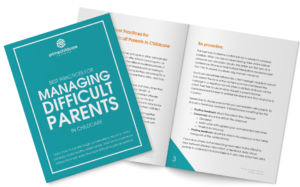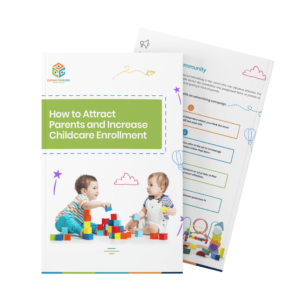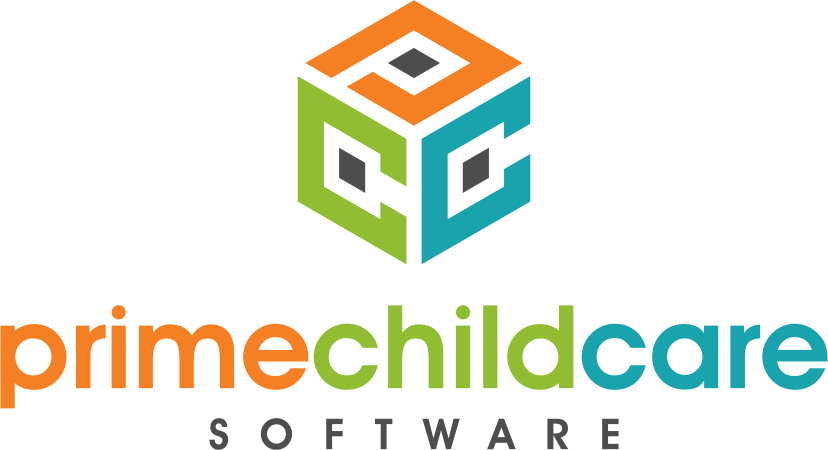The benefits of parental engagement in early childhood education are many. In fact, strong collaborative partnerships between parents and childcare providers can transform the learning environment.
Of course, parental engagement confers obvious benefits from an administrative standpoint. Parents pay tuition, after all. And, in the United States, they spend an eye-watering $42 billion dollars annually on early childcare. In all, the typical American family shells out about $6,000 a year for childcare costs. Yet, the real benefit of parental engagement is social in nature.
Studies consistently show that parental engagement fosters positive learning environments, raises test scores, and decreases negative behaviors. Parental engagement in early childhood education has far-reaching effects on children. According to research, children who enjoy high levels of parental involvement are less likely to engage in risky sexual behaviors later in life, less inclined to abuse substances, and more likely to excel in academics throughout adolescence.
However, creating an environment that promotes parental engagement isn’t easy. In a previous post, we discussed how child care providers can navigate relationships with demanding parents, but the simple truth is: most parents want to be involved in their children’s education. According to Pew Research, over half of parents believe that they can “never be too involved” in their children’s education.
In the past, child care centers have looked for ways to improve parental engagement by trying to create best-in-class activity programs. Those “bring-your-parents-to-daycare” days and “family field trips” are certainly powerful tools to increase parental involvement. But, today, we’re going to focus on the big picture.
Essentially, how can you facilitate parental engagement holistically? We won’t focus on classroom activities and special projects. Instead, our strategies drill deep into the core of the education framework.
1. Leverage Mobile Apps to Engage Parents on Their Terms
Almost everyone in America owns a cellphone or smartphone. Pew Research puts the figure at about 96%. In all, the average person spends about 3 hours a day on these mobile devices. Smartphones are the de facto form of communication for many. So, when it comes to involving parents in childhood initiatives, leveraging a highly-functional mobile app is the key to success.
But, first things first. One of the biggest barriers to parental engagement in early childhood education is work. According to Pew Research, working parents are generally less satisfied with their level of involvement in the classroom. Mobile apps keep parents informed about their children’s progress without having to be physically present.
But, what about emails and newsletters? Many childcare providers find that parents often ignore those. According to a study, millennials and, by extension, millennial parents actually prefer text to any other form of communication. More significantly, open rates for SMS texts (98%) dominate those of emails (20%).
If parents can access information regarding current programs, field trips, and projects, they gain the power to engage on their own terms. After work, they can connect with their children from a position of awareness — and understand what’s happening in class.
- Tip: There are backend benefits of mobile apps for parental engagement. It’s easier for parents to pay tuition, enroll in extra activities, and review critical future activities that may require a parental buy-in.
2. Create a Two-Way Channel of Engagement
In traditional settings, child care providers almost always facilitate conversations with parents. They send out emails, notifications, or texts regarding potential issues or upcoming events. And, parents respond to those messages with comments. However, this leaves a communications gap. You always initiate, while parents passively wait for word from you.
Instead of relegating parents to the background, give them more options to initiate conversations with you. By setting up mobile messaging boards, two-way text chains, and email channels, you can receive more parental feedback. The exact methodology you use to set up two-way channels of engagement is largely preference-related. You can create a Facebook group, offer video calls, or even share a dedicated mobile phone number with parents. Essentially, the actual channel matters less than how you communicate the value of that channel.
Parents should know that feedback is welcomed. In a sense, you want to create an atmosphere of trust and inclusivity. A feedback-centered culture empowers parents to stay abreast of their children’s education.
- Tip: Encourage parents to drop feedback on these channels. 33% of adults admit that they will consider leaving a brand after just ONE negative experience. Worse yet, you probably won’t know what those negative experiences are until it’s too late. 91% of people part ways without voicing their concerns. While two-way channels of communication make excellent parental engagement tools, they can also help you reduce churn and keep children enrolled in your program.
3. Focus on Daily Engagement
Ad-hoc classroom activities don’t directly increase parental engagement. Also, some studies show that parental involvement in the classroom alone has little to no impact on learning. That said, consistent communication is the key to facilitating greater parental engagement. So, you need an engagement framework that encourages consistent and holistic communication.
Again, this can be unlocked by mobile phone apps or superb multi-channel communications. However, it’s also achieved by re-framing the way you approach parental engagement. Instead of encouraging parents to participate in fractured, ad-hoc settings, give them the tools to consistently engage with their child’s learning.
Sending parents daily progress reports through mobile app push notifications is a great start. You want to keep them informed about their child’s daily progress. Beyond basic homework and class projects, giving them the ability to view photos and read daily announcements helps them stay fully engaged.
All things considered, you can’t directly control how involved parents are in their children’s lives. But, you can give them the tools to make it easier for them to do so.
Create a Holistic Parental Engagement Framework With Prime Child Care
We know that galvanizing parental engagement can be a challenge. You signed up to deal with children — not parents. But, the truth is this: creating a best-of-breed parental engagement program can help you improve your learning ecosystem, reduce student churn, and keep the lights on.
At Prime Child Care Software, we believe that parental engagement is a core component of a healthy child care ecosystem. That’s why we have parental engagement features built directly into our all-in-one child center management solution. With a handy mobile app and plenty of unique engagement features to keep parents in-the-loop, we can help you facilitate a stronger and more robust learning environment.
Also, having a mobile app with the same name as your center increases brand prominence and customer loyalty. If you’d like to learn how Prime Child Care can help with a customized mobile app that specifically targets parental engagement, contact us today.
Recent Articles from Prime:

Best Practices For Managing Difficult Parents
Whether you are a veteran teacher, center director or staff member, at some point in your career as a childcare worker, you will encounter difficult-to-please parents. Learn how to handle tough conversations about a child’s behavior, build healthy relationships, and avoid unpleasant interactions with even the most difficult-to-please parents. … Read More

Adding a New Revenue Stream With Drop-In Childcare
Hard times call for creative measures. Learn how to diversify your income stream with drop-in care. … Read More

3 Lies About Daycare Teacher Evaluations
No one cheers when you announce there will be a staff evaluation soon. Read more for a few tips and tricks if you want to make the process go smoother! … Read More

6 Easy-to-Implement Montessori Math Ideas
Children thrive in an environment where they are active participants in their learning. If you run a daycare, it is important to help children acquire numerical skills through the Montessori system. While creating a similar classroom may not be scalable due to budget constraints, there are numerous ideas you can adopt to create a Montessori learning environment in your facility. … Read More

5 Tips on Running a Successful Drop-In Program
Drop-in daycare can be a lucrative revenue stream for your daycare center, too. Before you start a drop-in program, though, it’s important to know the pros and cons of adding one. … Read More

How to Attract Parents and Increase Childcare Enrollment Guide
There is an art to attracting and winning over parents when you are trying to boost your enrollment.
Check out this guide for some tips that will help you to help tackle the question of how to increase the number of enrolled and waitlisted kiddos for your center. … Read More










